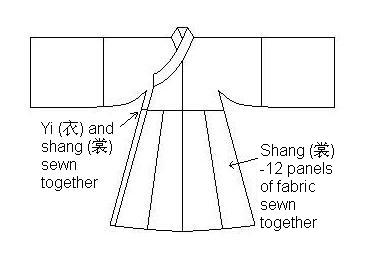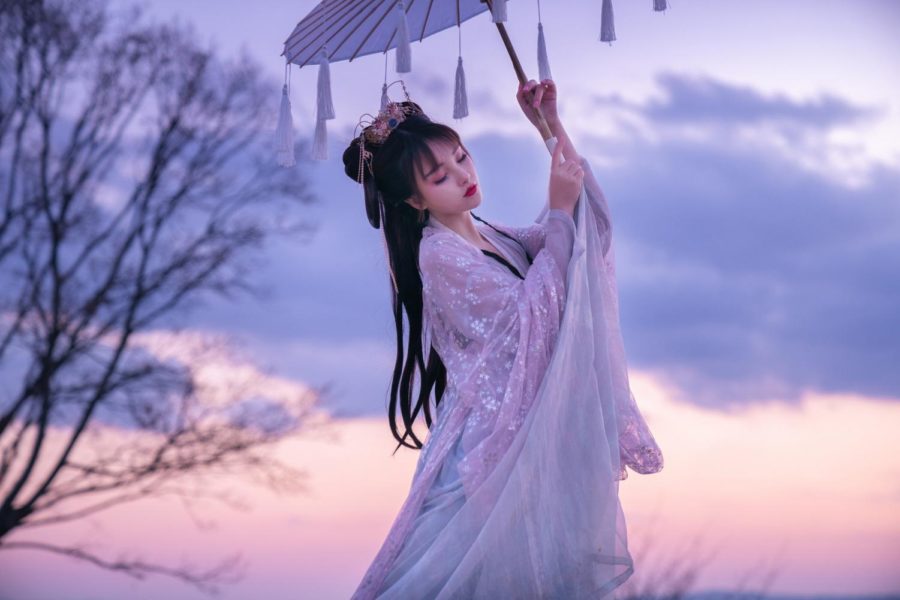The History of Hanfu Design and Its Influence Today
An overview of hanfu design from the Shang Dynasty to the Ming Dynasty.
Here is a photo of a woman wearing a Hanfu from the Han Dynasty.
While celebrating the festivities in China, one may notice that many – male and female, young and old – may be seen wearing elaborate headpieces and silky, flowing robes with billowing sleeves embroidered with lotus flowers and dragons. The grandeur of their attire imbues them with an almost divine presence reminiscent of mythical beings from an ancient era.
Upon seeing this attire worn during the celebrations, some people may become confused as they may be more familiar with the qipao, the other Chinese national dress. Additionally, they may mistake the ornate robes for the Korean hanbok or the Japanese kimono. Although some elements may be similar, these garments are Hanfu. In China, Hanfu is considered the authentic style of historical clothing from any era when the Han Chinese were in power.

The Hanfu Movement
Wang Letian of Zhengzhou, China, is credited with the resurgence of Hanfu, as he played a significant role in repopularizing the style. On November 2003, Letian made a public appearance wearing a handmade shenyi-style hanfu.
After witnessing this event, Zhang Congxing, a Singaporean-Chinese writer, was inspired to write an article about him. The piece was later published in Singapore’s Lianhe Zaobao daily and helped ignite the Hanfu Movement, which aimed to rekindle interest in traditional Han Chinese clothing and culture.
Various factors have contributed to the increased interest in Hanfu, including its portrayal in popular media, such as historical dramas and movies where actors are wearing Hanfu. Moreover, social media platforms such as Bilibili and Douyin have contributed to the surge in interest in traditional clothing. Users can share photos and videos of themselves wearing Hanfu, which has helped to spread awareness and appreciation for the style among a wider audience.
These platforms have facilitated the emergence of new Hanfu trends such as “daily Hanfu guidelines” and “genderless, streetwear Hanfu.” These trends have gained traction among young people who pair Hanfu items with popular Western fashion brands such as Balenciaga sneakers and Supreme sweatshirts. Additionally, many users post travel-related vlogs with themes such as wearing Hanfu in other countries have also become popular.
Thanks to media exposure, over twenty million people have purchased Hanfu on the e-commerce platforms such as Taobao. In July 2019, Alibaba, another e-commerce company, introduced the Gutao App, a social network dedicated to Hanfu shopping to cater to the rapidly growing consumer demand. Shisanyu, a direct-to-consumer brand founded in 2016, serves as a testament to the popularity of Hanfu. It has topped the site’s list as one of the ten best-selling brands in 2017 and is valued at 16 million dollars.
The Modern Hanfu
Currently, mixing Hanfu with Western-style clothing has become a fashionable trend. This trend emerged towards the end of the 20th century, when the Chinese government opened the country to the outside world, leading to increased exposure to Western culture. As a result, Chinese society started to embrace Western customs and fashion, which, in turn, impacted their traditional attire.
This trend emerged because wearing traditional Hanfu can be quite cumbersome. Modern enthusiasts have found a way to make it more convenient by mixing it with modern pieces. As a result, a new form of Hanfu, known as modern Hanfu or new Hanfu, has emerged, which combines traditional Chinese attire with westernized elements. New hanfu is classified into several varieties based on its characteristics, such as form, patterns, and aesthetics. Despite being inspired by Western fashion, modern hanfu has a unique design that distinguishes it from Western apparel.
History of The Hanfu

The Hanfu has gone through several iterations throughout history, providing contemporary enthusiasts with more choices. Many modern fans prefer the Tang, Song, and Ming dynasties.
Throughout history, the Hanfu has gone through various iterations, offering contemporary enthusiasts more choices. Many modern fans prefer the Tang, Song, and Ming dynasties.
The basic design was established during the Shang Dynasty (1600–1046 BC). The yi was a knee-length tunic with narrow cuffs, fastened with a sash, while the shang was a short skirt reaching the ankle. Additionally, a knee-length bixi or apron was worn on the outside. At that time, the Hanfu was predominantly green or red since it was believed that the dyeing techniques of the Shang Dynasty were not as advanced as the later dynasties. Due to this colors of the clothing were limited. Additionally, green and red are considered auspicious colors in Chinese culture and were commonly used in ceremonies and rituals.
During the Western Zhou Dynasty (1045–771 BC), clothing was used as a status symbol to underline the considerable differences between the aristocrats and the peasants. The aristocracy wore elaborate and luxurious clothing made from silk. In contrast, peasants wore plain clothing made from hemp and cotton. This significant difference in clothing between social classes highlighted the hierarchical structure of society, emphasizing the social and economic disparities.
During the Eastern Zhou Dynasty (770 – 221 BC), two styles were introduced: the Shenyi, a one-piece garment, and the Mianfu, a type of religious court clothing worn by ancient emperors and officials. Many people began to accessorize their Hanfu with belts and jade embellishments, and the sleeves widened to create a more elegant appearance.

The Hanfu saw few changes during the Qin and Han periods, as the Han still preferred the Shenyi style. However, a new ceremonial clothing called the Pao, a linen robe, emerged during this time. During the Qin Dynasty, wearing green silk Pao and Shenyi was mandatory for third-rank officials and higher, while the rest wore white linen Pao.
“China’s golden period” occurred during the Sui and Tang dynasties, when Han culture expanded, and women enjoyed more freedom from the constraints of Confucian ethical rules. This led to the introduction of looser and more revealing clothing for women compared to previous periods.
Many modern enthusiasts preferred the clothing from these two eras. For example, Vienna Chen ’26, a member of the Chinese Cultural Club (CCC), said she “like[s] the Sui Dynasty the most because, while it is troublesome to wear, it is pretty and feels more visually striking to [her] with the sash.” Like Vienna, Lotus Guo ’23, the president of the CCC club, also prefers clothes from the Sui Dynasty. Lotus explains, “I like the Sui Dynasty because I like flowy clothing more and the sash is very aesthetically pleasing to look at.”
Others appreciated the greater freedom that women had during this period. According to Nina Xie ’23, “The Hanfu in the Tang Dynasty also reflects the influence of the open and kind atmosphere of that time. If you look at some paintings of clothing designed during the Tang Dynasty, you will notice that women were not as conservative as they were in other dynasties, which indicates that they had more freedom. As a result, the patterns on the clothing were lively and not plain, which I enjoy.”
Song Dynasty attire primarily inherited the fashion of the Tang Dynasty, with more emphasis on embellishments and needlework. Women wore Beizi, which were similar to capes, during this period.
The Yuan Dynasty, which marked the beginning of foreign dominance over China, saw the Hanfu incorporating elements from the national clothing of Mongolian emperors. In addition to the usual round-collar pao in Han culture, men wore the Mongolian zhi fu or jism, which consisted of a short shang and a knee-length yi (upper garment) with thin sleeves (lower garment).
The Ming Dynasty was the last dynasty ruled by the Han, and during this time, the emperor aimed to restore Han culture and tradition, which included adopting the Tang Dynasty’s wardrobe. However, some outfits and headgear with Mongolian influences and modifications to clothing from the Song era remained popular. With the return and widespread acceptance of Confucian values, women’s clothing became more traditional once again. The outer coat was lengthened to shorten the length of the exposed skirt, while the upper outer garment was made shorter and the lower outer garment was made longer.
Following the Ming Dynasty, the hanfu was gradually replaced by Manchu clothing, which includes the qipao, cheongsam, and changsam. With the overthrow of feudalism in 1911, the popularity of traditional Chinese clothing waned, and Western fashion began to take hold in China.
The Hanfu Movement has provided a platform for younger generations to connect with and embrace Chinese culture. By wearing Hanfu, people can express their cultural identity which was previously suppressed during the Cultural Revolution, where personal expression was limited. Today, people have the freedom to choose how they dress and express themselves, and the Hanfu Movement has become a way for many to reconnect with their cultural roots. During the Spring Festival, Lantern Festival and many others, many have the choice to dress in the Tang Suit, Qipao, Cheongsam or the Hanfu.
Today, people have the freedom to choose how they dress and express themselves, and the Hanfu Movement has become a way for many to reconnect with their cultural roots.
Ellena Wang is a News Editor for 'The Science Survey.' Journalism appeals to Ellena since it is a method that enables journalists to inform the reader...











